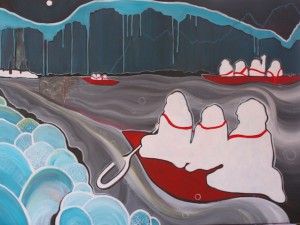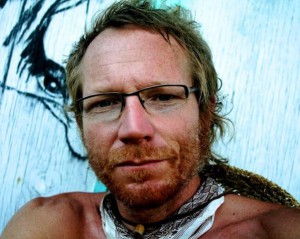The Wildest Part of the River, A Timeless Current.
{Photo via stephaniekellett.com}
By Robert E. Livingood.
It was a cold full moon night in February.
On the edge of a little village in the mountains where draft dodgers, cultural outlaws, and back-to-the-landers have begun to create a new world as the old one crumbles, we rendezvous.
There were ten of us. We met at the river, bringing three canoes.
She stood on the bank and watched as her people loaded up, piling blankets, food, tobacco, and warm tea into the boats — whatever each would need to enhance their experience. In her pocket was a needle and thread. She used them to weave people into her family.
We shoved off into the current with laughter, jokes, and some foolery as the moon ascended from behind the ridge. Its light through the fog gave the impression that the sky itself was frozen onto the mountain.
The canoes went slowly downstream, traveling at the hydrologic cycle’s pace as it makes its great circle from meltwaters in the high country, down the small tributaries, into the rivers that flow to the ocean, then back up into the sky again as oceanic evaporation.
With each stroke, water dribbled from the paddles, sounding like the ringing of tiny bells.
I was in the canoe with her.
We went slower than the others, intentionally dragging our paddles so we could feel the night a little more, lingering as long as we could in that timeless current, that same river flowing from enchanted times all the way into the present — we being the Weaver, the Painter, and me — the Writer.
I imagined what it was like before the settlers arrived — the unmechanized sonic richness, the wisdom held within the cellular memory of the uncut forests, the camps of the First People of this region established along the banks to venerate and feed from power spots along the way.
So much has been lost since those days. Both the old growth and salmon are gone, grizzlies in the valley bottom are almost non-existent, wolves are just slightly more substantial than rumors, and now there are only a handful of those First People left, the Sinixt.
Still, floating down the river that night, their energetic broadcast was as sure as salmon signatures biologists have found written into the isotopes of the oldest remaining trees.
{Photo via stephaniekellett.com}
Trumpeter swans called out from their sanctuary downstream. Sensitive to encroachment, they had good reason to be wary of humans. At the turn of the Twentieth Century, they were taken to the point of extinction.
The Weaver hoped her people wouldn’t be too much of a disturbance to them, wanting to believe the swans could sense that underneath our layers of wool and polar fleece her family were as pure as them.
At the widest part of the river was an island. We landed there and unloaded our things. Within a circle of tall dead-standing cottonwood trees, we lit a fire. Orange light illuminated the old giants.
They were branchless, grey, completely stripped of bark. Having given their last breath of oxygen long ago, they stood as massive organic monuments to a wild past.
They formed a circle around us as we formed a circle around the fire, all of us watching as the flames liberated what remained of the downed wood’s essence as smoke and sparks back up to heaven.
It felt symbolic — this disparate band, a tribe of sorts, a pocket of warmth amidst winter’s death, gathering together in the February cold to celebrate the moon’s full ascension.
“This is how it will be,” the Weaver leaned close and whispered to me, “when civilization is but a memory and our relationships to each other and to the Earth mean more than anything.”
*****
{Photo via stephaniekellett.com}
Robert E. Livingood is a cultural outlaw and escape artist whose life’s mission is wriggling free from the chains of convention. He’s a writer, dj, installation artist, former-grizzly-scientist-turned-bear-groupie, and deep wilderness guide. His work aims to recouple people with their authentic nature and inspire them to live full on. He’s written three books, performs at international arts/music festivals such as Shambhala and Burning Man, and journeys into North America’s wildest places. You could visit his blog or listen to his Soundcloud.




